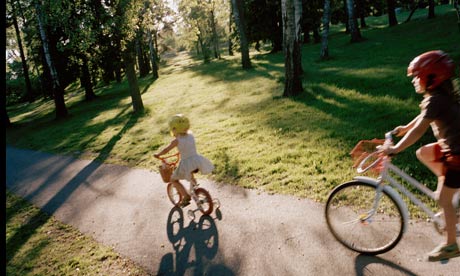
Children cycling to school. It's one of those things, much like apple pie, that in theory everyone supports. Pupils get exercise, stay slim, and arrive in the classroom energised, ready – well, nearly ready – to face the day. At a stroke you do away with the 9am and 3pm gridlock around schools, cutting emissions... the list goes on.
And while cycling to school remains ubiquitous in some places (Denmark, the Netherlands, the usual suspects) in the UK it has declined steadily since the 1970s. Now it's the main form of transport for a pathetic 2% of pupils.
The reasons for this are many. Safety, of course, is the one cited most commonly by parents, not all of whom appreciate the bitter paradox that in ferrying their offspring a mile each way in an armour-plated 4x4 they only serve to perpetuate this situation. More widely, adults who rarely if ever cycle themselves are unlikely to encourage the practice in their kids.
Even the once-ubiquitous school bike sheds are now often absent, a reason cited by the small number of schools who, ludicrously, have an outright ban on pupils travelling by bike.
It's thus heartening to learn that things can change, however slowly. Sustrans are best known to most UK cyclists as the charity behind a network of mainly off-road bike routes. However, they also carry out work in schools, doing everything from teaching bike maintenance to constructing storage sheds.
In a press release today, Sustrans said that polls of pupils showed the number riding to and from schools where it had worked for a year at least once a week doubled on average to 26.6%. It's not wholly scientific – a show of hands – but the sample is big, taking in more than 40,000 pupils in 254 schools across England, Wales and Northern Ireland.
Malcolm Shepherd, chief executive of Sustrans, had this to say on the benefits:
Over the last 30 years, children's opportunities to be active and travel independently on foot or bike have rapidly declined, so children are much less physically active, with the consequence that obesity rates among children are shockingly high.
Simply encouraging kids to choose an active way of getting to school will get them outdoors and exercising everyday, help them be more alert and ready to learn when they get to school and lead to a nation of healthier, more independent children.
You can't really argue with that. Even if only a quarter of children riding just once a week or more isn't high by some other countries' standards, it's a great start.
Sustrans gave me a few more details. Apparently they're involved in more than 1,000 schools in all, with 58 members of staff working in in schools in England and Wales. Activities include "bike breakfasts", where parents and others can quiz a Sustrans bike officer, organised bike rides, maintenance classes and skills training.
Those familiar with such efforts will probably know that the flagship scheme for training young cyclists in this country is Bikeability, the hugely popular scheme which lives on for now despite the demise of its former patron, Cycling England. But it's encouraging to hear about Sustrans' results with such a relatively tiny number of people.
It would be nice to think that Bikeability and Sustrans together could one day make cycling to school the norm. But I'm not sure I can see it happening without one (admittedly major) change – many more segregated bike lanes. As a cyclist I can see the logic of bikes being accepted as part of the normal traffic, and recognise that it's largely safe. But as a parent (mine is only 13 months; this is still theoretical for me) I'd most likely take a different view.

